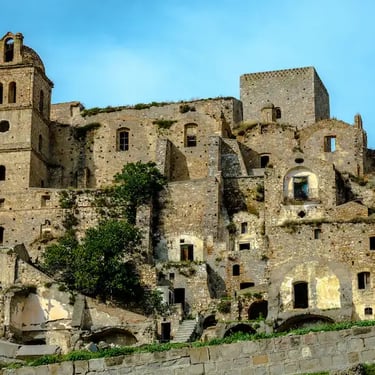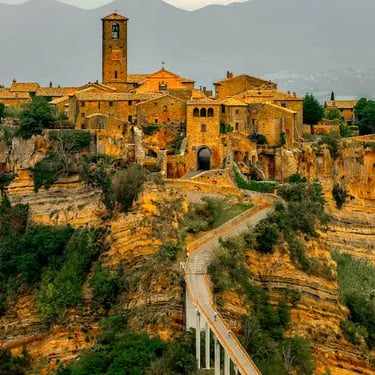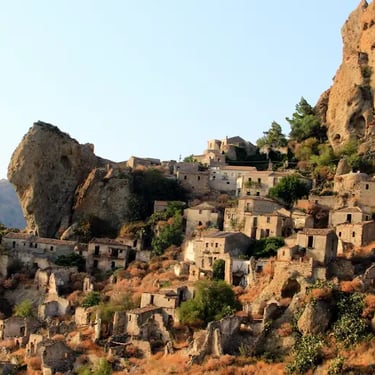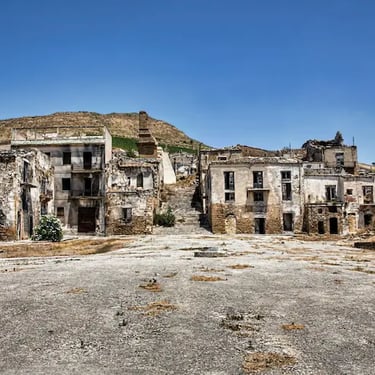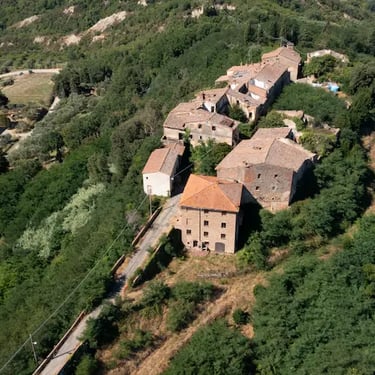10 Incredible Ghost Towns in Italy You Can Still Visit (Full Travel Guide)
Explore 10 hauntingly beautiful ghost towns in Italy — from Craco to Civita di Bagnoregio. Travel tips, history, and how to visit safely.
LOCAL STORIES&CULTURE
Italy is not only famous for its bustling cities and historic landmarks – it's also home to dozens of ghost towns: villages long abandoned by their inhabitants. These eerie places were often deserted due to natural disasters (earthquakes, landslides, floods) or economic decline, and many appear frozen in time. From the mountains of the north to the islands of the south, you can find crumbling ruins and silent streets that whisper stories of the past. Visiting these offbeat destinations is like stepping into a time capsule – an unforgettable experience for adventurous travelers. In this article, we'll journey through 10 of the most fascinating Italian ghost towns, covering different regions and the various reasons they became abandoned. The tone here is informal and personal – as if a friend is guiding you – so get ready for a road trip into Italy’s eerie side!
Before we dive in, a quick note: Many ghost towns are open-air museums or freely accessible ruins, but some have restricted access or safety precautions. Always check local guidelines, wear sturdy shoes, and respect any barriers or signs. Now, let's explore these hauntingly beautiful places and see what makes each unique – including useful tips for travelers who’ve never been there.
1. Craco, Basilicata – The Cinematic Ghost Hilltown
High on a hill in Basilicata sits Craco, perhaps Italy’s most famous ghost town. Once a medieval village of farmers, Craco was plagued by poor agriculture, earthquakes, landslides, and even war over the centuries. The final blow came in 1963 when a landslide (triggered by unstable soil and water infrastructure) forced the evacuation of the remaining residents to a valley nearby. Since then, Craco’s stone houses and narrow alleys have been completely deserted – left exactly as they were, as if the inhabitants vanished overnight.
Walking through Craco is a surreal experience. The ghost town is perched on a steep summit, giving it a dramatic skyline visible for miles. Its crumbling walls and silent piazzas have an eerie charm, which hasn’t gone unnoticed by filmmakers. In fact, Craco’s unique atmosphere made it a backdrop for movies like The Passion of the Christ (the hanging of Judas scene) and the James Bond film Quantum of Solace. Today, for safety, visitors can only enter with a guide – hard hats are required to protect against falling debris while you wander the abandoned streets. Peering into ruined churches and peeking through empty doorways, you’ll feel like you’re traveling back in time.
Travel Tip: If you’re planning a visit to Craco, book a guided tour in advance (helmets are usually provided) and wear sturdy shoes. The town is about an hour’s drive from Matera, making it a great roadside stop on a southern Italy road trip.
Ready to explore Craco for yourself? Start planning your trip now! : https://gyg.me/rhEH5kwy
2. Civita di Bagnoregio, Lazio – The “Dying City” on a Cliff
Imagine a tiny medieval town perched atop a pinnacle of brittle clay and rock, connected to the modern world only by a long footbridge – that’s Civita di Bagnoregio. Often nicknamed “Italy’s Dying City,” Civita is slowly crumbling as the plateau edges fall away into the canyon below. Founded over 2,500 years ago by the Etruscans, this fairy-tale hamlet in Lazio now has only a dozen or so residents left. Over the centuries, erosion and earthquakes have caused most people to leave, and neighboring villages have dubbed Civita la città che muore (the dying town).
Despite its morbid moniker, Civita di Bagnoregio is full of life – at least in daytime, thanks to curious travelers. To reach Civita, you’ll walk across a dramatic pedestrian bridge with sweeping views of the Calanchi Valley. Once inside the ancient gate, you find a charming frozen-in-time village: stone cottages adorned with flowers, a quiet piazza with a Renaissance church, and kittens sunning themselves on deserted doorsteps. There are a few small cafes and shops catering to visitors, but the vibe is wonderfully tranquil, especially in off-peak hours. Note that Civita charges a small entrance fee (a few euros) to help preserve the town, and it’s well worth it.
Travel Tip: Civita is a pedestrian-only town – wear comfortable shoes for the bridge hike (and lots of stairs inside the village!). Consider visiting early or on weekdays to avoid crowds, and stay for sunset if you can (the last light on the stone buildings is magical).
Eager to see Civita di Bagnoregio? Plan your trip now and witness the Dying City before it’s gone!: https://gyg.me/mNxXMrBF
3. Pentedattilo, Calabria – Five Fingers of Legend
Pentedattilo is a ghost town clinging to the cliffs of Calabria, in Italy’s deep south. Its memorable name comes from the shape of the giant hand-like rock looming above it – penta daktylos means “five fingers” in Greek. Founded way back in 640 BC as a Greek colony, Pentedattilo has seen its share of drama. It was sacked by Saracen pirates and other invaders in antiquity. In 1783, a devastating earthquake struck the region, causing part of the mountainside to collapse and convincing most remaining residents to eventually relocate to safer ground. By the 1960s, Pentedattilo was completely abandoned.
Today, Pentedattilo has a second life. Beginning in the 1980s, volunteers and locals gradually restored some of the old buildings and repopulated the village in a limited way. As you wander its steep, cobbled paths, you’ll find a mix of crumbling ruins and modestly repaired houses now used as artisan workshops, small museums, or guesthouses. The setting is incredibly scenic and a bit spooky: towering rock spires above, the Ionian Sea in the distance, and scarcely a sound but the wind.
Travel Tip: You can drive to Pentedattilo (about 45 minutes from Reggio Calabria) via winding mountain roads – the journey itself offers stunning views. Bring water and snacks, as there are no shops or restaurants open regularly (except during special events).
Ready to wander the silent streets of Pentedattilo? Start planning your Calabria ghost town adventure!: https://gyg.me/eIgm97os
4. Antica Monterano, Lazio – Ruins in the Roman Countryside
Just an hour’s drive northwest of Rome lies Antica Monterano, an atmospheric ghost town now engulfed by nature. This abandoned village sits on a wooded hilltop near Canale Monterano and Lake Bracciano. It thrived in ancient times and the Middle Ages, but by the late 18th century Monterano was forsaken – first ravaged by a French invasion in 1799, then finished off by malaria in the area. The surviving residents fled to neighboring towns, leaving Monterano to crumble quietly. Today it’s the centerpiece of a regional nature reserve, where hiking trails lead you through history.
Exploring Monterano feels like discovering a secret. Under the shade of oak trees, you’ll come across the shells of baroque buildings: a palazzo and a church with a fountain façade designed by Bernini, now roofless and wrapped in vines. An ancient aqueduct cuts across the landscape, and near the ruins of a convent, thermal springs gurgle. The whole place is so picturesque that it served as a set for films like Ben-Hur and Ladyhawke.
Travel Tip: Monterano’s ruins are free to visit and always open, but you have to hike in. Park at the nearby lot for the Monterano Natural Reserve, then follow an easy trail (about 20-30 minutes walk) to reach the ghost town. Early morning or late afternoon visits are best for cooler temperatures and magical light for photos.
5. Poggioreale, Sicily – Earthquake-Frozen “Modern Pompeii”
In western Sicily’s Belice Valley, Poggioreale stands as a tragic time capsule of the 20th century. This once-bustling town was utterly devastated by a powerful earthquake in 1968. In the aftermath, the survivors relocated and rebuilt a new Poggioreale a few kilometers away, leaving the old town’s wrecked remains behind.
Walking into Poggioreale’s ruins, you see the layout of a typical Sicilian town – but everything is in shambles. The church stands roofless, its shattered bell tower leaning precariously. Former homes and shops line the weed-choked streets; you can still spot faded store signs and peeling pastel plaster on the walls. Because of safety concerns, Poggioreale is officially closed off, but determined explorers often find a way in through gaps in the fence – caution is advised!
Travel Tip: Poggioreale’s ghost town is remote – you’ll need a car to get there (about 1.5 hours from Palermo). If you go, exercise caution and respect – this is essentially a memorial to a tragedy. Nearby, you can also visit the Cretto di Burri in Gibellina – a massive artwork covering another quake-ruined town.
Intrigued by Poggioreale’s ghostly appeal? Map out a Sicilian road trip to witness this modern ruinscape for yourself! : https://gyg.me/UfRBcuUJ
6. Roscigno Vecchia, Campania – The Early 1900s Village Time Forgot
Tucked in the Cilento region of Campania, Roscigno Vecchia offers a rare peek into rural Italian life circa 100 years ago – preserved by abandonment. In the early 20th century, a slow-moving landslide threatened this small farming village, prompting a relocation of the inhabitants around 1902 to a new settlement uphill. By the mid-20th century, Old Roscigno was completely deserted, left with just its stone houses, tiny chapel, and central olive tree-shaded piazza intact.
Strolling into Roscigno Vecchia, you’ll likely be greeted by the only “resident” – not a ghost, but a friendly caretaker who looks after the village. The buildings around the main square are wonderfully preserved in a shabby way – you can peek into an old schoolroom with wooden desks, see the smithy’s workshop, and explore houses with their hearths and wine presses as they were left.
Travel Tip: Roscigno Vecchia is free to visit and easy to reach by car (about 2 hours from Naples, in the Cilento National Park). Bring a camera and take your time exploring – the vibe is very relaxed.
7. Bussana Vecchia, Liguria – The Artist-Reborn Ghost Town
Not all ghost towns stay ghostly – Bussana Vecchia is a prime example of a village literally brought back to life. Located in Liguria near the Riviera town of San Remo, Bussana Vecchia was a thriving hilltop community until February 1887, when a massive earthquake struck the region. The quake destroyed most buildings and killed many residents. Deemed unsafe, the old village was completely abandoned, and survivors founded a new town down by the coast. For over 60 years, “Old Bussana” was left to crumble silently, inhabited only by ghosts and overgrown fig trees.
Then came the artists. In the late 1950s and 60s, bohemian artists from Italy and abroad squatted in the ruins of Bussana Vecchia, drawn by its romantic desolation. They gradually rebuilt habitable sections using whatever materials they could find, setting up studios, workshops, and galleries. Despite periodic evictions and even an official order to demolish the village, the artist community persisted. Fast-forward to today, and Bussana Vecchia is a unique hybrid – part ghost town, part quirky arts village. As you wander the narrow lanes, you’ll pass roofless stone houses decked in bougainvillea, alongside little boutiques selling ceramics, paintings, and jewelry. The old church still stands roofless as a haunting reminder of the quake, but just around the corner you might find a cozy café offering espresso and homemade focaccia. It’s a place where creativity grew from ruin, and a bohemian spirit fills the air.
Travel Tip: Bussana Vecchia is accessible by car (a short drive from San Remo) but you’ll need to park below and walk up a steep path to the village entrance. Plan to spend a leisurely afternoon here – browse the artisans’ shops, chat with the friendly residents (many speak English), and enjoy the scenic views of the Mediterranean. There are a couple of cafés and a trattoria for lunch, but note that business hours can be irregular.
8. Balestrino, Liguria – Mystery in the Hills (Look, Don’t Touch)
Deep in the olive-clad hills of Liguria, the mysterious Balestrino sits in silence, looking like a perfect ghost town postcard. This small medieval town has obscure origins – little is documented about its early history. What is known is that by the late 19th century it had a population of around 800, mostly farmers, under the rule of local marquises. A powerful earthquake hit Liguria in 1887, badly damaging Balestrino and spurring a gradual exodus. The final straw was ongoing geological instability (landslides and tremors) that led authorities in 1953 to declare the old town unsafe. The last 400 residents were relocated, leaving Balestrino completely abandoned – a ghost town “frozen in time” ever since.
From afar, Balestrino is hauntingly beautiful: a cluster of stone houses and a church tower nestled beneath a grand hilltop castle. Up close, it’s even more intriguing – cracked walls, empty window frames, and nature slowly reclaiming the narrow alleys. However, visiting Balestrino comes with a catch: the old town has been closed to the public for safety. Fences and warning signs bar entry, and the decaying buildings truly are at risk of collapse. That doesn’t stop determined urban explorers from sneaking in, but the official stance is to admire Balestrino from outside. The best viewpoints are from the new Balestrino village nearby or from the road leading up – where you can see the 12th-century church of San Andrea and the outline of once-lived-in homes. There have been plans to restore and reopen the ghost town for tourism, but progress is slow. The air of mystery remains thick here, and the town’s perfectly still appearance even featured in films. Standing at the barricade, you feel a bit of a forbidden thrill – like you’re gazing at a real-life Sleeping Beauty village under a spell.
Travel Tip: You can drive right up near old Balestrino (about 1 hour from Genoa or 30 minutes from Albenga). Even if you can’t go inside, it’s worth the trip for the panoramic views and photos. Pair it with a visit to the Ligurian coast – the contrast between lively beach towns and this silent hill town is striking. Sometimes the best travel experiences are about what you don’t do, and in Balestrino’s case, looking but not touching might be the wise choice.
9. Consonno, Lombardy – The Abandoned Las Vegas of Italy
This next ghost town isn’t centuries old – it’s a 1960s relic of wild ambition gone wrong. Consonno lies in the Brianza hills of Lombardy, not far from Milan. For most of its history, Consonno was just a quiet rural hamlet of a few hundred people. But in 1962 a wealthy entrepreneur, Count Mario Bagno, bought the entire village with a grandiose plan: to turn it into a pleasure city, a kind of Italian Las Vegas in the countryside. He evicted the residents, demolished their homes (except the church), and over a few years built a bizarre playground of entertainment. There were hotels, restaurants, a ballroom, a fake medieval castle entrance, a minaret tower, and even a giant fake cannon – all in clashing styles from around the world. Neon signs at the entrance declared slogans like “In Consonno, the sky is bluer” and “It’s always a party in Consonno.” And for a brief moment, it actually worked – in the late 1960s, Consonno’s “City of Toys” drew curious crowds, hosting famous singers and lavish parties.
That moment didn’t last long. By the 1970s, the novelty was fading... and then nature dealt the final blow. In 1976, heavy rains triggered a landslide that wiped out the only road to Consonno. Suddenly, Count Bagno’s fantasy town was cut off and effectively doomed. Attempts to revive it failed, and Consonno fell into abandonment and decay. Today, what remains is a post-apocalyptic ghost town: the shells of the arcade and hotel, the broken minaret tower, and remnants of those optimistic billboards, all covered in colorful graffiti. It’s a favorite spot for urban explorers, street artists, and curious travelers. On weekends, you might even find locals holding a street art or music event amid the ruins, bringing a bit of life back occasionally. Walking around, you can’t help but be amazed at the scale of this project – it’s fun, eerie, and sad all at once.
Travel Tip: Consonno is about 1 hour by car from Milan. The road to the village is sometimes gated except on certain days. Usually, you’ll park before a barrier and walk the last stretch up to the ghost town. There are no facilities (except maybe a pop-up bar during events), so bring water. Keep an eye out for event announcements – the local association occasionally organizes festivals like a spring chestnut festival or vintage car shows, which are a fun way to experience Consonno in a semi-live state.
10. Toiano, Tuscany – Abandoned Hamlet in the Tuscan Hills
Even the popular region of Tuscany has its secrets – one of them is Toiano, a tiny ghost village perched between Pisa and Volterra. Unlike many ghost towns, Toiano wasn’t emptied by a single catastrophe; it gradually lost its inhabitants due to isolation and changing times. Once a medieval farming community, Toiano had only a handful of residents by the mid-20th century, and eventually the last families left. Today it remains completely deserted, one of the few places in Tuscany untouched by mass tourism. No restaurants, no souvenir shops, not even electricity – just a cluster of old stone buildings on a ridge, surrounded by stunning countryside.
Visiting Toiano is like stepping into a painting. You cross a little bridge to enter the village, passing through intact defensive walls into a single street of rustic houses. At the far end rises a crumbling church tower and a small cemetery. Everything else is wonderfully silent – you hear only the breeze and birds. Many of the buildings are in ruin, but a few have been modestly restored, hinting that some people do care for this place. The atmosphere is both peaceful and eerie; you might feel chills knowing one of Tuscany’s most infamous unsolved murders happened here in 1947, adding a ghostly legend to the town. Mystery aside, the real allure of Toiano is its untouched authenticity. You can imagine the small community that once was – women at the well and men returning from the fields – because the layout and even some old wooden doors remain as they were.
Travel Tip: Toiano is a bit off the beaten path. You’ll need a car to get there – it’s about 45 km from Pisa. The final approach is a narrow road from the town of Palaia. There is no infrastructure in Toiano itself, so visit in daylight and bring anything you need. It’s an easy short walk from where you park to the village – truly like walking into a time warp.
Final Tips for Ghost Town Explorers
Visiting Italy’s ghost towns is incredibly rewarding for those who love history, photography, or just a bit of adventure. Remember to always prioritize safety – many structures are unstable, so heed posted warnings and never climb in off-limits areas. Go prepared with water, snacks, and good footwear, as these locations usually lack amenities (after all, they’re abandoned!). A flashlight or headlamp can be useful for dark interiors, but be mindful and avoid causing any damage.
Lastly, take your time and soak in the atmosphere. Each of these ghost towns has its own story and soul. Whether it’s the cinematic skyline of Craco, the artistic revival of Bussana Vecchia, or the silent streets of Toiano, these places offer a travel experience you won’t find in any guidebook. So, fuel up your car, grab your camera, and get ready to step into Italy’s past – the roadside adventure of a lifetime awaits in these ghostly villages.
Ready to hit the road and explore Italy’s eerie abandoned towns? Start planning your itinerary – these ghostly gems are waiting for you!
